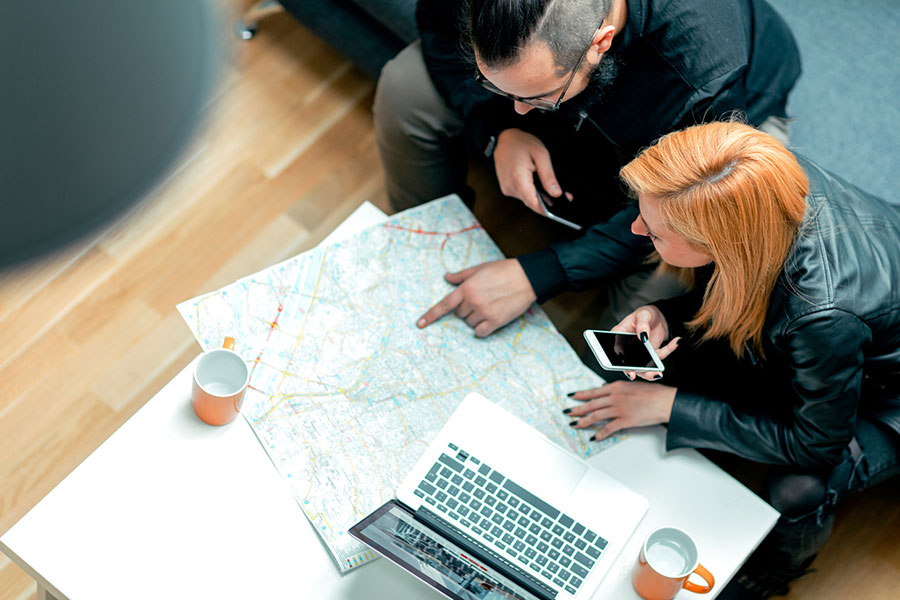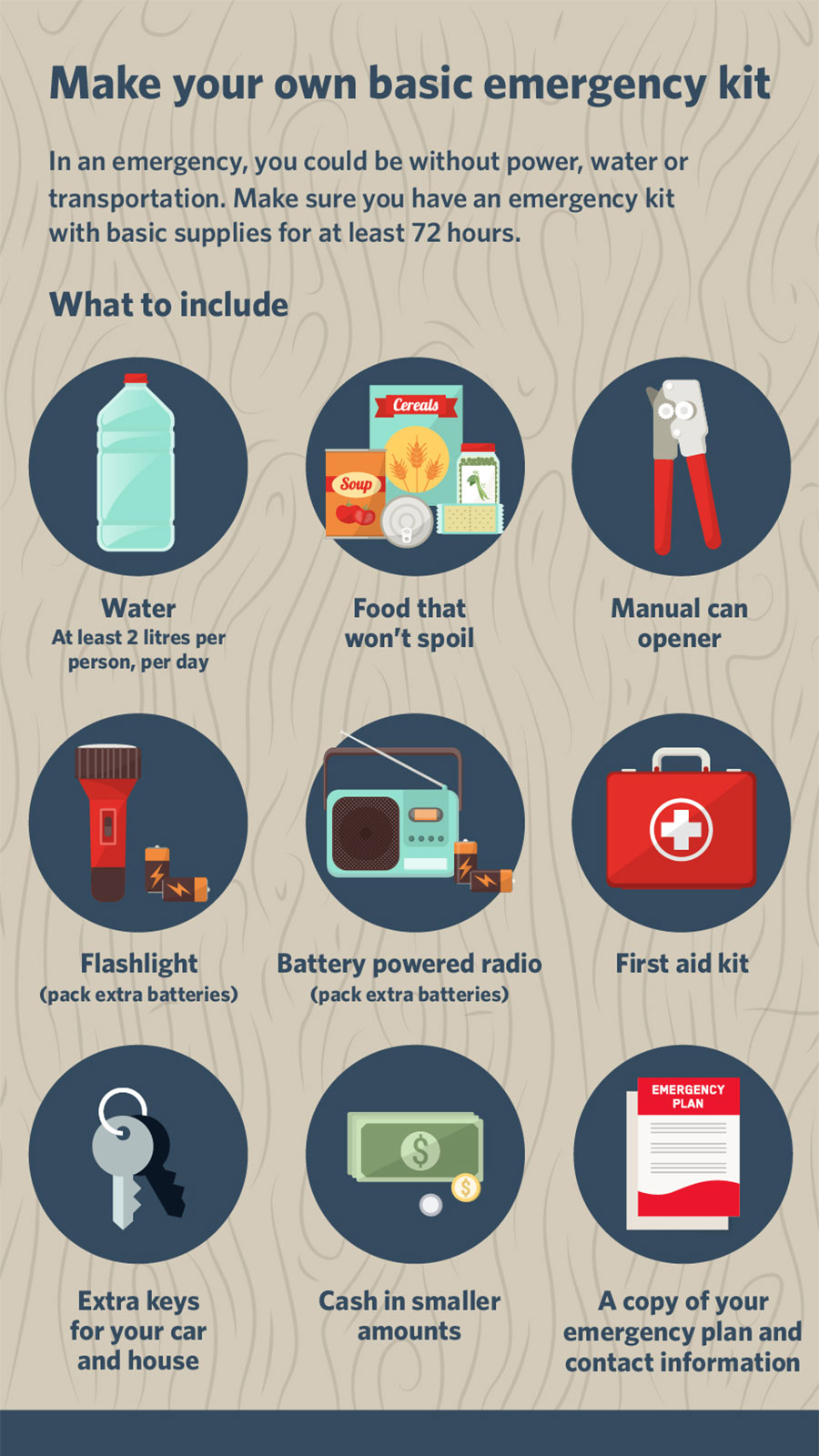Keep calm and leave town
Less than 24 hours before Fort McMurray was evacuated on Tuesday, May 3, 2016, the local wildfire situation had shown signs that the worst might be averted. Voluntary evacuation alerts for a nearby business park and a residential area had been downgraded to “shelter-in-place.” People could stay put, even if they could not yet breathe a sigh of relief.
Then, conditions changed again. High winds and temperatures around 30 C pushed the fire eastward. By noon on Tuesday, it had jumped the nearby Athabasca River. Officials issued new notices. By 2 p.m., residents in neighbourhoods on the south side of town were told to leave; others were advised to be ready to go on 30 minutes’ notice.
At 6:25 p.m., an alert went out to the entire municipality: Get out. Now. As it turned out, residents wouldn’t be allowed back for a month.
“Nobody ever thought you’d have to evacuate the entire city of Fort McMurray. They did,” says Josh Bowen, manager of NAIT’s Centre for Applied Disaster and Emergency Management, which provides hands-on training and professional development in line with global best practices.
And now, with recent flooding, some Fort Mac residents are having to pack up and go once again.
Seven of Canada’s 10 costliest disasters have been in the province.
For Bowen, the tragic examples speak to how Albertans need to be ready to mobilize in the face of an emergency – and these days more than ever. Seven of Canada’s 10 costliest disasters have been in the province, he points out. Six of those have happened since 2010.
“Everybody says it’s not going to happen here,” says Bowen. “The reality is that it is happening. And it will continue to happen.” Wildfires are not the only threat, he adds. Calgary and much of southern Alberta flooded in 2013. An F4 tornado struck Edmonton on July 31, 1989.
Should the order come for any one of us, as it has for Fort McMurray, Slave Lake, High Level and other communities, would we be ready to pack the vehicle, gather the family and leave town at a moment’s notice? If not, here’s what Bowen recommends we do.
Make a plan
 First, says Bowen, “know what the risks are.” Do you live near a river that could flood? Are you surrounded by trees that could go up in flames? “If you live in a community with one way in and one way out and there are a thousand homes there, everybody will be taking that one way out. It’s going to take you a long time to get out. Understanding those risks is critical.”
First, says Bowen, “know what the risks are.” Do you live near a river that could flood? Are you surrounded by trees that could go up in flames? “If you live in a community with one way in and one way out and there are a thousand homes there, everybody will be taking that one way out. It’s going to take you a long time to get out. Understanding those risks is critical.”
"Understanding risks is critical.”
That understanding will help you choose in advance a safe place for your family to meet in case a disaster has cut off communication. It may also help you determine where you’ll go to be safe and, if they’re available, alternate routes to get there.
Gather supplies
Get things together as if trouble is a foregone conclusion. In Fort McMurray, the order to evacuate due to the fires likely did not come as a surprise (in fact, some firefighters were surprised it did not come sooner). Still, it would not have offered enough time for all residents to gather what they needed before leaving.
Eight hours isn’t much if you’re starting your emergency planning from scratch.
People in High River, says Bowen, got an eight-minute warning before rising waters crested in 2013. Slave Lake, victim of a devastating fire in 2011, was put on an eight-hour alert when fires threatened again last May. But even eight hours isn’t much if you’re starting your emergency planning from scratch.

Bowen has enough food and water on hand at any given moment for 96 hours (four days). At the very least, he says, “make sure you have supplies for 72 hours.” These include:
- eight litres of water per person per day (for drinking, sanitation and cooking)
- food that won’t spoil and that you often eat anyway
- medications
- clean clothes
- N95 masks to protect against airborne particulate matter from a wildfire

Don’t leave without copies of key documents as well, such as:
- medical prescriptions
- home insurance policy
- deed to your home
- passport and driver’s license
- credit cards
- a list of phone numbers of family and friends (in case your cellphone dies and takes your contacts directory with it)
- alternatively, take pictures of everything and store it in the cloud, says Bowen. “When you need it – and I’m saying when – you’ll have it”

If you’re travelling with small children, be sure to have a grab-bag of:
- diapers
- bottles
- formula
- toys and activities – “As we saw with the [2016] Fort McMurray evacuation, people were on the roads for hours,” Bowen says. An iPad will only last so long
- and don’t forget that favourite blanket or stuffie

Pets need to go with you as well, Bowen says, “because you don’t know when you’re going to come back.” Hundreds of animals had to be rescued in High Level this spring, he adds. “That’s the other part of having that emergency kit ready to go. Do you have enough food for Fluffy and Spot?” Stash the kennel somewhere handy.
"Do you have enough food for Fluffy and Spot?”
As for the rest of your evacuation kit, keep it somewhere that’s out of the way but makes it easy to grab everything and go.
Listen to the authorities
“If you’re told [to leave], get out,” says Bowen. Mandatory evacuation orders, “are not things that are done lightly. They are only done if there’s an imminent threat to life, the environment, property and the economy. But life safety is the most important thing.”
Keep calm – you’ve got this

As Bowen mentioned, having to deal with disaster is more of a matter of when than if. “The reality is that climate change is happening and that means we are experiencing more severe weather events,” he says. “If you look at every year, we’re setting new records: biggest disaster, most tornadoes, most days above 30 degrees.
“When you’re consistently breaking records, you’re consistently being exposed to more extreme events.”
Bowen wants to raise awareness of the need to prepare for the worst but he doesn’t want us to live in fear of it. “When this happens,” he advises, “remember that you’ve got this. We deal with little disasters and emergencies every day. Take a breath.
“And that’s going to be so much easier if you’ve taken the five minutes to think about what you need to do, told your family [the plan], and have taken a few pictures.”
